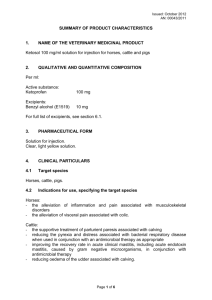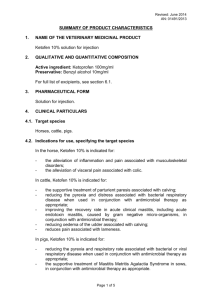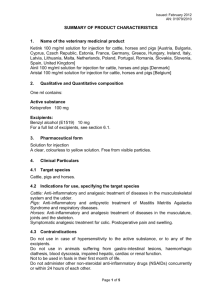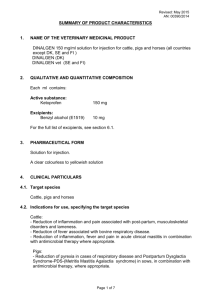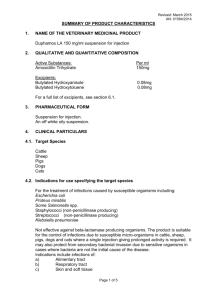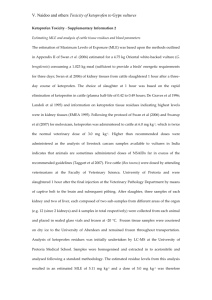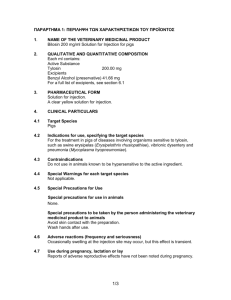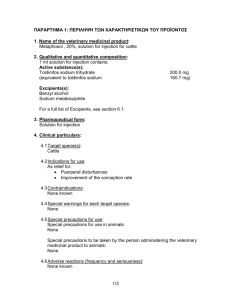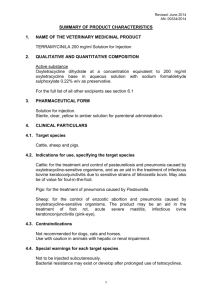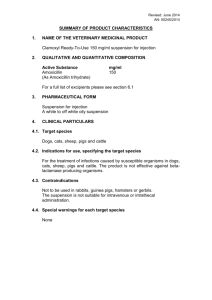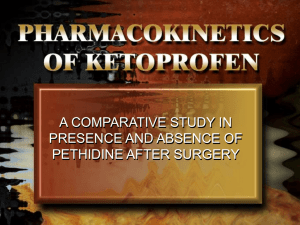No clinical signs were observed when ketoprofen was administered
advertisement
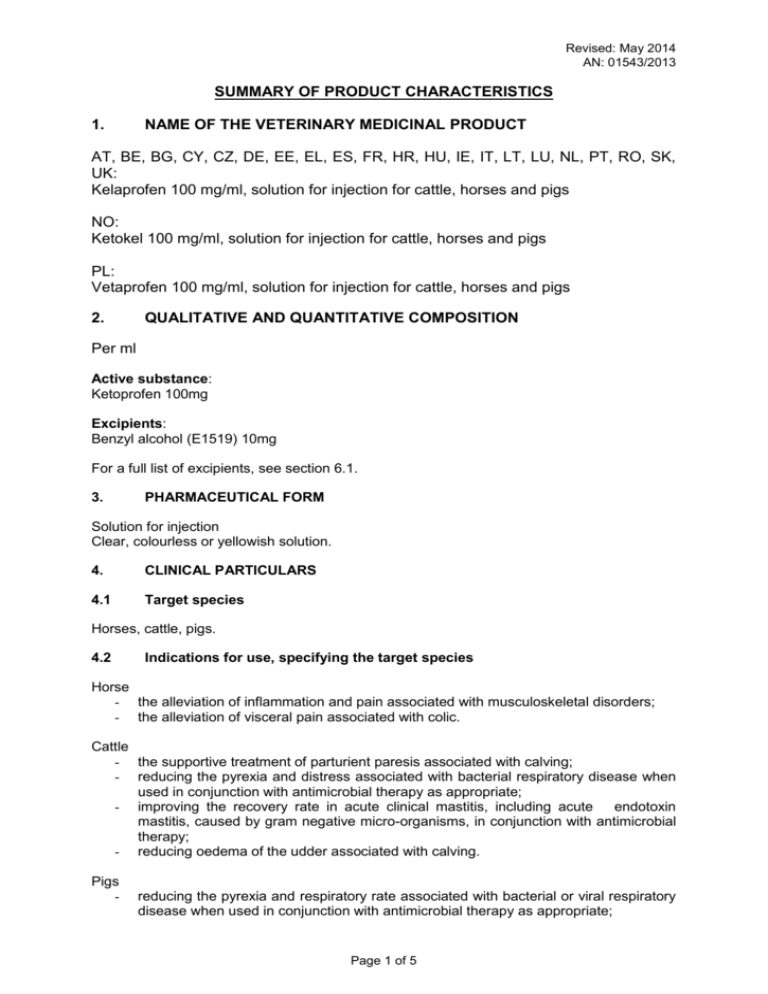
Revised: May 2014 AN: 01543/2013 SUMMARY OF PRODUCT CHARACTERISTICS 1. NAME OF THE VETERINARY MEDICINAL PRODUCT AT, BE, BG, CY, CZ, DE, EE, EL, ES, FR, HR, HU, IE, IT, LT, LU, NL, PT, RO, SK, UK: Kelaprofen 100 mg/ml, solution for injection for cattle, horses and pigs NO: Ketokel 100 mg/ml, solution for injection for cattle, horses and pigs PL: Vetaprofen 100 mg/ml, solution for injection for cattle, horses and pigs 2. QUALITATIVE AND QUANTITATIVE COMPOSITION Per ml Active substance: Ketoprofen 100mg Excipients: Benzyl alcohol (E1519) 10mg For a full list of excipients, see section 6.1. 3. PHARMACEUTICAL FORM Solution for injection Clear, colourless or yellowish solution. 4. CLINICAL PARTICULARS 4.1 Target species Horses, cattle, pigs. 4.2 Indications for use, specifying the target species Horse - the alleviation of inflammation and pain associated with musculoskeletal disorders; - the alleviation of visceral pain associated with colic. Cattle - the supportive treatment of parturient paresis associated with calving; - reducing the pyrexia and distress associated with bacterial respiratory disease when used in conjunction with antimicrobial therapy as appropriate; - improving the recovery rate in acute clinical mastitis, including acute endotoxin mastitis, caused by gram negative micro-organisms, in conjunction with antimicrobial therapy; - reducing oedema of the udder associated with calving. Pigs - reducing the pyrexia and respiratory rate associated with bacterial or viral respiratory disease when used in conjunction with antimicrobial therapy as appropriate; Page 1 of 5 Revised: May 2014 AN: 01543/2013 - 4.3 the supportive treatment of Mastitis Metritis Agalactia Syndrome in sows, in conjunction with antimicrobial therapy as appropriate. Contra-indications Do not use in animals with known hypersensitivity to the active substances or to any of the excipients. Do not administer other non-steroidal anti-inflammatory drugs (NSAIDs) concurrently or within 24 hours of each other, corticosteroids, diuretics and anticoagulants. Do not use in animals suffering from cardiac, hepatic or renal disease, where there is the possibility of gastro-intestinal ulceration or bleeding, or where there is evidence of blood dyscrasia. 4.4 Special warnings for each target species None. 4.5 Special precautions for use (i) Special precautions for use in animals The use of ketoprofen is not recommended in foals under the age of 15 days. Use in any animal less than 6 weeks of age or in aged animals may involve additional risk. If such use cannot be avoided animals may require a reduced dosage and careful management. Avoid use in any dehydrated, hypovolaemic or hypotensive animals as there is a potential risk of increased renal toxicity. Avoid intra-arterial injection. Do not exceed the stated dose or duration of treatment. (ii) Special precautions to be taken by the person administering the medicinal product to the animals People with known hypersensitivity to the active substance and/or benzyl alcohol should avoid contact with this product In case of accidental self injection, seek medical advice and show the package leaflet or label to the physician. Wash hands after use. Avoid splashes on the skin and eyes. Wash affected area thoroughly with water should this occur. If irritation persists seek medical advice. 4.6 Adverse reactions (frequency and seriousness) In common with all NSAIDs, due to their action of inhibition of prostaglandin synthesis, there can be the possibility in certain individuals of gastric or renal intolerance. Allergic reactions may occur very rarely. Page 2 of 5 Revised: May 2014 AN: 01543/2013 4.7 Use during pregnancy, lactation or lay The safety of Ketoprofen has been investigated in pregnant laboratory animals (rats, mice and rabbits) and cattle. Ketoprofen showed no teratogenic or embryotoxic effects. Ketoprofen may be given to pregnant and lactating cattle. As the safety of ketoprofen has not been assessed in pregnant sows, the product should be used in these cases only accordingly to the benefit/risk assessment by the responsible veterinarian. Do not use in pregnant mares. 4.8 Interaction with other medicinal products and other forms of interaction Do not administer with other non steroidal anti-inflammatory drugs (NSAIDs) concurrently or within 24 hours of each other, corticosteroids, diuretics or anticoagulants. Some NSAIDs may be highly bound to plasma proteins and compete with other highly bound drugs which can lead to toxic effects. Concurrent administration with nephrotoxic drugs should be avoided. 4.9 Amounts to be administered and administration route Use of a draw-off needle is recommended when treating large groups of animals. Do not broach the container more than 33 times. Horse: Intravenous administration. For use in musculo-skeletal conditions: 2.2 mg ketoprofen/kg i.e. 1ml of product per 45 kg body weight, administered by intravenous injection once daily for up to 3 to 5 days. For use in equine colic: 2.2 mg/kg (1 ml/45 kg) body weight, given by intravenous injection for immediate effect. A second injection may be given if colic recurs. Cattle: Intravenous or intramuscular administration. 3 mg ketoprofen/kg body weight, i.e. 1 ml of product per 33 kg body weight, administered by intravenous or deep intramuscular injection once daily for up to 3 days. Pigs: Intramuscular administration. 3 mg ketoprofen/kg body weight, i.e. 1ml of product per 33 kg body weight, administered once by deep intramuscular injection. 4.10 Overdose (symptoms, emergency procedures, antidotes), if necessary No clinical signs were observed when ketoprofen was administered to horses at 5 times the recommended dose for 15 days, to cattle at 5 times the recommended dose for 5 days, or to pigs at 3 times the recommended dose for 3 days. Page 3 of 5 Revised: May 2014 AN: 01543/2013 4.11 Withdrawal periods Cattle: Meat and offal: - IV: 1 day - IM: 2 days Milk: zero hours Horses: Meat and offal: 1 day Milk: Not authorised for use in lactating animals producing milk for human consumption Pigs: Meat and offal: 2 days 5. PHARMACOLOGICAL PROPERTIES Pharmacotherpautic group: Anti-inflammatory, antirheumatic products, non-steroids, propionic acid derivatives. ATC Vet Code: QM01AE03 5.1 Pharmacodynamic properties Ketoprofen is a derivative of phenylpropionic acid, and belongs to the non steroidal antiinflammatory group of drugs. Like all such substances, its principal pharmacological actions are anti-inflammatory, analgesic and anti pyretic. The mechanism of action is related to the ability of ketoprofen to interfere with the synthesis of prostaglandins from precursors such as arachidonic acid. 5.2 Pharmacokinetic properties Ketoprofen is rapidly absorbed. The maximum plasma concentration is reached in less than an hour after parenteral administration. The bioavailability is about 80 to 95%. Ketoprofen binds strongly to plasma proteins (about 95%), allowing its accumulation in the exudate at the site of inflammation. The action is longer than what should be expected from the plasma half-life that varies between one and four hours depending on the species. Ketoprofen enters the synovial fluid and remains there at higher levels than in plasma, with a half-life two to three times higher than in plasma. Ketoprofen is metabolized in the liver and 90 percent is excreted in the urine and is complete after 96 hours. 6. PHARMACEUTICAL PARTICULARS 6.1 List of excipients L-Arginine Benzyl Alcohol (E1519) Citric Acid Monohydrate (for pH adjustment) Water for Injection 6.2 Incompatibilities In the absence of compatibility studies, this product should not be mixed with other substances in the same syringe. Page 4 of 5 Revised: May 2014 AN: 01543/2013 6.3 Shelf-life Shelf-life of the veterinary medicinal product as packaged for sale: 30 months. Shelf-life after first opening of the immediate packaging: 28 days. 6.4 Special precautions for storage Do not refrigerate or freeze. Protect from light. 6.5 Nature and composition of immediate packaging Nature of the container: Amber glass vials type II of 50, 100 and 250 ml, closed with bromobutyl rubber stoppers and aluminium caps, packed in an outer carton. Clinical containers of 6, 10 and 12 units of 50 ml, 100 ml and 250 ml. Not all pack sizes may be marketed. 6.6 Special precautions for the disposal of unused veterinary medicinal product or waste materials derived from the use of such products, if appropriate Any unused veterinary medicinal product or waste materials derived from such veterinary medicinal products should be disposed of in accordance with local requirements. 7 MARKETING AUTHORISATION HOLDER KELA N.V., St. Lenaartseweg 48, 2320 Hoogstraten, BELGIUM 8. MARKETING AUTHORISATION NUMBER Vm 06126/4000 9. DATE OF FIRST AUTHORISATION 27 February 2012 10. DATE OF REVISION OF THE TEXT May 2014 Page 5 of 5
